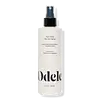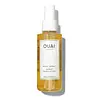What's inside
What's inside
 Key Ingredients
Key Ingredients

 Benefits
Benefits

 Concerns
Concerns

 Ingredients Side-by-side
Ingredients Side-by-side

Water
Skin ConditioningPPG-5-Ceteth-20
EmulsifyingIsobutylene/Ethylmaleimide/Hydroxyethylmaleimide Copolymer
Polysorbate 20
EmulsifyingPropanediol
SolventAlcohol Denat.
AntimicrobialTamarindus Indica Seed Gum
Emulsion StabilisingCocos Nucifera Water
MaskingGlycerin
HumectantPanthenol
Skin ConditioningPhyllostachys Bambusoides Juice
Skin ConditioningHydrolyzed Hibiscus Esculentus Extract
Skin ConditioningDaucus Carota Sativa Root Extract
Skin ConditioningJasminum Officinale Flower Extract
MaskingNasturtium Officinale Extract
PerfumingZingiber Officinale Root Extract
MaskingAmaranthus Caudatus Seed Extract
Skin ConditioningOryza Sativa Extract
AbsorbentCystoseira Compressa Extract
Hydrolyzed Linseed Extract
Skin ConditioningPisum Sativum Extract
Skin ConditioningLaurdimonium Hydroxypropyl Hydrolyzed Keratin
Skin ConditioningHydrolyzed Rice Protein
Skin ConditioningOryza Sativa Seed Protein
AntioxidantHydrolyzed Corn Protein
Skin ConditioningHydrolyzed Yeast Protein
Skin ConditioningSodium PCA
HumectantSodium Lactate
BufferingArginine
MaskingAspartic Acid
MaskingPCA
HumectantGlycine
BufferingAlanine
MaskingSerine
MaskingValine
MaskingProline
Skin ConditioningThreonine
Isoleucine
Skin ConditioningPhenylalanine
MaskingHistidine
HumectantZea Mays Starch
AbsorbentTocopherol
AntioxidantMoringa Oleifera Seed Extract
Skin ConditioningSodium Polystyrene Sulfonate
Emulsion StabilisingCystine Bis-Pg-Propyl Silanetriol
Skin ConditioningHydrolyzed Vegetable Protein Pg-Propyl Silanetriol
Skin ConditioningEthylhexylglycerin
Skin ConditioningParfum
MaskingPolysilicone-15
UV FilterLeuconostoc/Radish Root Ferment Filtrate
AntimicrobialPentylene Glycol
Skin ConditioningDisodium Phosphate
BufferingCitric Acid
BufferingChlorphenesin
AntimicrobialBenzyl Alcohol
PerfumingDehydroacetic Acid
PreservativeDisodium EDTA
Aminomethyl Propanol
BufferingBHT
AntioxidantCaprylyl Glycol
EmollientPhenoxyethanol
PreservativePotassium Sorbate
PreservativeSodium Benzoate
MaskingGluconolactone
Skin ConditioningCalcium Gluconate
HumectantPhytic Acid
Phenethyl Alcohol
MaskingLinalool
PerfumingAlpha-Isomethyl Ionone
PerfumingLimonene
PerfumingGeraniol
PerfumingHydroxycitronellal
PerfumingCitronellol
PerfumingCI 42090
Cosmetic ColorantCI 17200
Cosmetic ColorantCI 19140
Cosmetic ColorantCI 15985
Cosmetic ColorantWater, PPG-5-Ceteth-20, Isobutylene/Ethylmaleimide/Hydroxyethylmaleimide Copolymer, Polysorbate 20, Propanediol, Alcohol Denat., Tamarindus Indica Seed Gum, Cocos Nucifera Water, Glycerin, Panthenol, Phyllostachys Bambusoides Juice, Hydrolyzed Hibiscus Esculentus Extract, Daucus Carota Sativa Root Extract, Jasminum Officinale Flower Extract, Nasturtium Officinale Extract, Zingiber Officinale Root Extract, Amaranthus Caudatus Seed Extract, Oryza Sativa Extract, Cystoseira Compressa Extract, Hydrolyzed Linseed Extract, Pisum Sativum Extract, Laurdimonium Hydroxypropyl Hydrolyzed Keratin, Hydrolyzed Rice Protein, Oryza Sativa Seed Protein, Hydrolyzed Corn Protein, Hydrolyzed Yeast Protein, Sodium PCA, Sodium Lactate, Arginine, Aspartic Acid, PCA, Glycine, Alanine, Serine, Valine, Proline, Threonine, Isoleucine, Phenylalanine, Histidine, Zea Mays Starch, Tocopherol, Moringa Oleifera Seed Extract, Sodium Polystyrene Sulfonate, Cystine Bis-Pg-Propyl Silanetriol, Hydrolyzed Vegetable Protein Pg-Propyl Silanetriol, Ethylhexylglycerin, Parfum, Polysilicone-15, Leuconostoc/Radish Root Ferment Filtrate, Pentylene Glycol, Disodium Phosphate, Citric Acid, Chlorphenesin, Benzyl Alcohol, Dehydroacetic Acid, Disodium EDTA, Aminomethyl Propanol, BHT, Caprylyl Glycol, Phenoxyethanol, Potassium Sorbate, Sodium Benzoate, Gluconolactone, Calcium Gluconate, Phytic Acid, Phenethyl Alcohol, Linalool, Alpha-Isomethyl Ionone, Limonene, Geraniol, Hydroxycitronellal, Citronellol, CI 42090, CI 17200, CI 19140, CI 15985
 Reviews
Reviews

Ingredients Explained
These ingredients are found in both products.
Ingredients higher up in an ingredient list are typically present in a larger amount.
This ingredient comes from the seed of the velvet flower. It has skin hydrating, nourishing, and antioxidant properties.
This seed is rich in peptides, fatty acids, squalene, vitamin C, and vitamin E.
According to manufacturer, this ingredient is great for adding softness and shine to hair.
Learn more about Amaranthus Caudatus Seed ExtractCitric Acid is an alpha hydroxy acid (AHA) naturally found in citrus fruits like oranges, lemons, and limes.
Like other AHAs, citric acid can exfoliate skin by breaking down the bonds that hold dead skin cells together. This helps reveal smoother and brighter skin underneath.
However, this exfoliating effect only happens at high concentrations (20%) which can be hard to find in cosmetic products.
Due to this, citric acid is usually included in small amounts as a pH adjuster. This helps keep products slightly more acidic and compatible with skin's natural pH.
In skincare formulas, citric acid can:
While it can provide some skin benefits, research shows lactic acid and glycolic acid are generally more effective and less irritating exfoliants.
Most citric acid used in skincare today is made by fermenting sugars (usually from molasses). This synthetic version is identical to the natural citrus form but easier to stabilize and use in formulations.
Read more about some other popular AHA's here:
Learn more about Citric AcidEthylhexylglycerin (we can't pronounce this either) is commonly used as a preservative and skin softener. It is derived from glyceryl.
You might see Ethylhexylglycerin often paired with other preservatives such as phenoxyethanol. Ethylhexylglycerin has been found to increase the effectiveness of these other preservatives.
Glycerin is already naturally found in your skin. It helps moisturize and protect your skin.
A study from 2016 found glycerin to be more effective as a humectant than AHAs and hyaluronic acid.
As a humectant, it helps the skin stay hydrated by pulling moisture to your skin. The low molecular weight of glycerin allows it to pull moisture into the deeper layers of your skin.
Hydrated skin improves your skin barrier; Your skin barrier helps protect against irritants and bacteria.
Glycerin has also been found to have antimicrobial and antiviral properties. Due to these properties, glycerin is often used in wound and burn treatments.
In cosmetics, glycerin is usually derived from plants such as soybean or palm. However, it can also be sourced from animals, such as tallow or animal fat.
This ingredient is organic, colorless, odorless, and non-toxic.
Glycerin is the name for this ingredient in American English. British English uses Glycerol/Glycerine.
Learn more about GlycerinHydrolyzed Rice Protein is protein extracted from rice. This ingredient is rich in antioxidants and peptides.
Studies show this ingredient may help with blocking the melanin creation process when skin is exposed to UV.
Parfum is a catch-all term for an ingredient or more that is used to give a scent to products.
Also called "fragrance", this ingredient can be a blend of hundreds of chemicals or plant oils. This means every product with "fragrance" or "parfum" in the ingredients list is a different mixture.
For instance, Habanolide is a proprietary trade name for a specific aroma chemical. When used as a fragrance ingredient in cosmetics, most aroma chemicals fall under the broad labeling category of “FRAGRANCE” or “PARFUM” according to EU and US regulations.
The term 'parfum' or 'fragrance' is not regulated in many countries. In many cases, it is up to the brand to define this term.
For instance, many brands choose to label themselves as "fragrance-free" because they are not using synthetic fragrances. However, their products may still contain ingredients such as essential oils that are considered a fragrance by INCI standards.
One example is Calendula flower extract. Calendula is an essential oil that still imparts a scent or 'fragrance'.
Depending on the blend, the ingredients in the mixture can cause allergies and sensitivities on the skin. Some ingredients that are known EU allergens include linalool and citronellol.
Parfum can also be used to mask or cover an unpleasant scent.
The bottom line is: not all fragrances/parfum/ingredients are created equally. If you are worried about fragrances, we recommend taking a closer look at an ingredient. And of course, we always recommend speaking with a professional.
Learn more about ParfumPhenoxyethanol is a preservative that has germicide, antimicrobial, and aromatic properties. Studies show that phenoxyethanol can prevent microbial growth. By itself, it has a scent that is similar to that of a rose.
It's often used in formulations along with Caprylyl Glycol to preserve the shelf life of products.
Polysorbate 20 is made by combining ethoxylation of sorbitan, ethylene oxide, and lauric acid. It is a mild cleansing agent, surfactant, and emulsifier.
As a surfactant, it helps collect dirt and oils for washing. Emulsifiers prevent oils and water from separating.
Polysorbate 20 also adds scent to a product. Since it is made using sorbitol, it has a sweet scent. Sorbitol can also be found in fruits such as apples and peaches.
The lauric acid used to create Polysorbate 20 is often derived from coconuts.
Polysorbate 20 may not be fungal acne safe.
Learn more about Polysorbate 20Propanediol is an all-star ingredient. It softens, hydrates, and smooths the skin.
It’s often used to:
Propanediol is not likely to cause sensitivity and considered safe to use. It is derived from corn or petroleum with a clear color and no scent.
Learn more about PropanediolWater. It's the most common cosmetic ingredient of all. You'll usually see it at the top of ingredient lists, meaning that it makes up the largest part of the product.
So why is it so popular? Water most often acts as a solvent - this means that it helps dissolve other ingredients into the formulation.
You'll also recognize water as that liquid we all need to stay alive. If you see this, drink a glass of water. Stay hydrated!
Learn more about Water